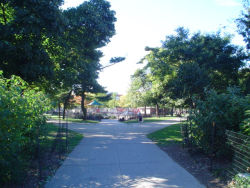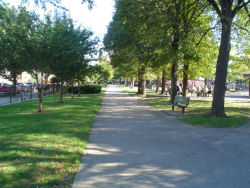Seth Low Playground/ Bealin Square
Seth Low Playground
What was here before?
Bensonhurst was once a rural section of the Dutch colonial town of New Utrecht. In the 1880s, land developer James Lynch bought land from the Benson family, after whom the neighborhood is named, and converted it into an exclusive community which he named Bensonhurst-by-the-Sea. When the area was linked with Manhattan by the Fourth Avenue subway line in 1915, the population rapidly increased. Two- and three-family houses and apartment buildings were built during the 1920s for the growing population of Italians and Jews from the Lower East Side and continued to grow following World War II
How did this site become parkland?
The City of New York acquired this property in 1924 by condemnation and built a playground on the site the same year. The playground itself was not officially named but was referred to as Seth Low Playground by local residents for many years. In 1987, Parks officially changed the name of both the playground and the adjacent square to Seth Low Playground. One year later, a new parkhouse was built in Seth Low Playground.
Who is this parkland named for?
This playground honors Seth Low (1850-1916), former president of Columbia College (1890-1901) – now Columbia University - and mayor of New York (1901-1903). Low was born in Brooklyn and educated at Brooklyn Polytechnic Institute and Columbia College. Graduating in 1870, he went on to study law but, joined the family’s tea and silk importing firm at his father’s request.
Low was a reformer in his family’s tradition. His grandfather organized the Brooklyn Association for Improving the Condition of the Poor, and in 1878, Low established the Bureau of Charities of Brooklyn. Low campaigned for James A. Garfield (1831-1881), the Republican candidate for president in 1880. Low himself served two two-year terms as mayor of the City of Brooklyn (1881-1885). During his time in office, he reorganized the public school system, instituted the merit system in municipal service, and reduced Brooklyn’s budget deficit.
After helping draft the charter that consolidated the five boroughs into New York City in 1898, Low ran for mayor of New York on the Citizens Union ticket but lost to the Tammany Hall candidate, Robert Van Wyck. In 1901, a citizenry outraged by the scandals of the Tammany administration swept Low into office. As he did in Brooklyn, Low instituted reforms in the police department, public schools, and city finances. He also presided over the development of important construction projects: a subway line between Manhattan and Brooklyn, the Pennsylvania Station tunnel to Long Island, and the electrification of the New York Central Railroad.
Low was named a trustee of Columbia College in 1880 and president of the school from 1890 to 1901. He initiated Columbia’s transformation from a college into a major university, establishing a graduate education program and creating affiliations with other institutions including Barnard College, Teachers College, and the College of Physicians and Surgeons. Low Memorial Library, which Low funded, is named for his father. Low remained a Columbia trustee until 1914, giving up his position to protest the policy of denying Jews access to university facilities. Until his death in 1916, Low remained active in civic affairs.
Check out your park's Vital Signs
Clean & Safe
Green & Resilient
Empowered & Engaged Users
Share your feedback or learn more about how this park is part of a
Vital Park System






